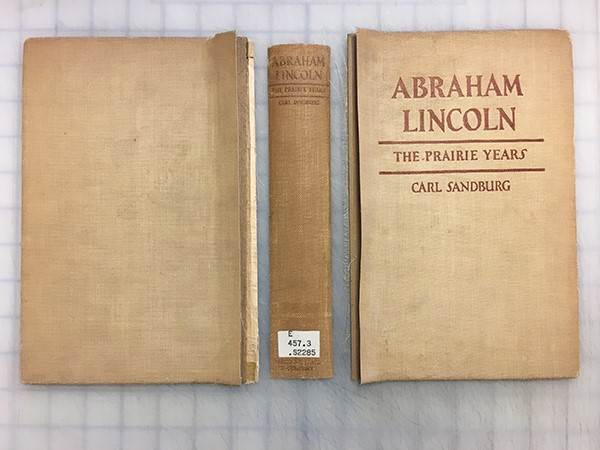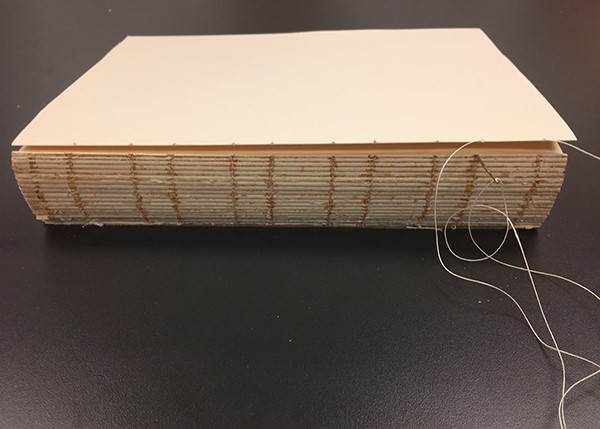By Ginny Lee
In the Conservation Lab at the ALPLM we use a variety of techniques to repair books, documents, and manuscripts. Sometimes when a book arrives in the lab, it needs a lot of help. Recently I rehabilitated a 1929 copy of Carl Sandburg’s Abraham Lincoln: the Prairie Years.
 Carl Sandburg wrote a famous biography of Abraham Lincoln. This is a 1929 edition of one of these volumes.
Carl Sandburg wrote a famous biography of Abraham Lincoln. This is a 1929 edition of one of these volumes.
Conservator Bonnie Parr, my supervisor, examines items coming into the lab and writes up a detailed Conservation Treatment Report, which includes the current condition of the item. This book required recasing with a new spine — removing the text block from the original cover, making repairs, creating a new cover spine and reassembling the book.
(As a librarian and lover of books, the first time I performed this procedure I was shocked to think of cutting a book apart, but after seeing the handsome result of putting it back together with tender, loving care, I stopped feeling aghast about it!)
I replaced damaged end papers with a folio of Rives archival paper and sewed the new pages onto the text block. I used Irish linen thread strengthened with beeswax and sewed the folded end pages into the first and last signatures of the book. A signature is simply a folded section of pages, which a bindery sews together to make a book. There are some 20 signatures in this book.
 The rehabilitation of the 1929 Carl Sandburg book in progress.
The rehabilitation of the 1929 Carl Sandburg book in progress.
After carefully measuring the height and width of the spine of the book, I created a new cover spine from blotting paper and camel-colored book cloth. We have a large variety of colors of book cloth in the department, and part of the satisfaction in this process is matching the new cloth to the original book cover. Often we can match it perfectly, as with this book.
The new cover spine is attached to the back cover of the book first with Polyvinyl Acetate glue. We slide the glued spine under a one-inch section of original book cloth and press it down with a bone folder. The new cover spine is glued the same way inside the front cover.
Gluing the end pages to the book boards is perhaps the most tedious part of this process. Making sure the text block is aligned correctly (so that the front cover is indeed attached to the front of the text) is vital. Great care is taken to line them up perfectly to ensure the book will open and close easily and precisely. The book is now recased and will lie between two pressboards in the standing press to dry overnight.
The final step is to glue the original cover spine (with title and author’s name) to the repaired spine of the book. We place the book in the lying press and carefully glue the cover spine on, then wrap the book in the press with an Ace bandage to secure it overnight. It is exciting to remove the bandage the next day and see the restored book.
Ginny Lee is a Library Specialist at the Abraham Lincoln Presidential Library and Museum.